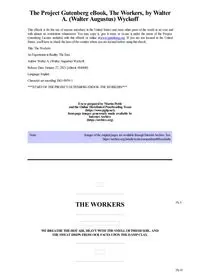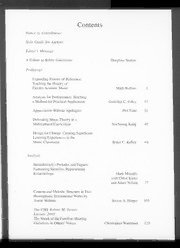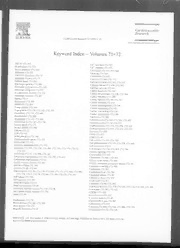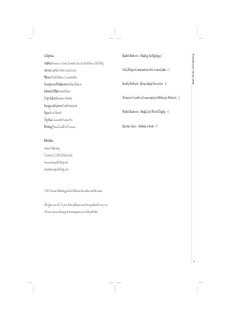
Kuehn Malvezzi – Making Archipelagos PDF
Preview Kuehn Malvezzi – Making Archipelagos
Colophon Kuehn Malvezzi – Making Archipelagos 3 C o m Authors Francesco Garutti, Kersten Geers, Kuehn Malvezzi, Hila Peleg m o Artists Candida Hoefer, Armin Linke Hila Peleg in Conversation with Armin Linke 13 n G Photos Ulrich Schwarz, Giovanna Silva ro u Concept and Production Kuehn Malvezzi Kuehn Malvezzi – Kinaesthetic Narratives 25 nd Editorial Office Samuel Korn Copy Editor Rosemary Heather Francesco Garutti in Conversation with Kuehn Malvezzi 33 Design and Layout Double Standards Paper ResaOffset 60 Kuehn Malvezzi – Models, by Way of Display 43 Typeface Garamond Premier Pro Printing NuovaLitoEffe srl, Piacenza Kersten Geers – Method as Form 55 Publisher Mousse Publishing Via Arena 23, I-20123 Milano, Italy www.moussepublishing.com info@moussepublishing.com ©2012 Mousse Publishing, Kuehn Malvezzi, the authors and the artists. All rights reserved. No part of this publication may be reproduced in any way or by any means without prior written permission of the publisher. 1 Hybrids K u e Esperanto is based on relation and just like a pidgin language makes identities h n M blur. It is a hybrid. Language parts of different origins are forged into a a lv composite language, artificial and concrete at once. Its elements relate to each ez z other in the generation of new meanings based on the in-between. Esperanto i – M as a transnational language is a considered cross-breeding with Universalist ak in ambitions; it is a modernist invention that met resistance in real life. Its failure g A to become a commonly spoken language is a fact, just as modern architecture rc h ip has not become part of the mainstream: there are other kinds of lingua franca e la today. Like Esperanto, architecture intended to constitute a common ground go s appears instead to be sectarian in the midst of contemporary pluralism. Seen this way, the failed artificial language appears as a mirror image of the failed ambitions of modern architecture to be relevant as a social common ground. Moreover, Esperanto as a form of paradoxically planned creolization poses questions we see as architectural in yet another way: we do not draw from a singular past but constantly compose and recompose various genealogies that we regard as fundamental. This makes us think of architecture not as one tradition or one culture. Rather it appears to be a network of influences absorbed and constantly recombined. If on the one hand the claim for an architectural universalism seems to be in stark contrast with the concept of spontaneous mingling and transformation, on the other hand this claim appears to be integral to sustaining a position in the presence of a pluralist culture of indifference. Following this paradox, the challenge of a common ground in architecture appears to reside in the question of whether our discipline is capable of being, at once, ideologically founded and inclusivist: making spaces of a shared heterogeneity. Curatorial Architecture Common ground implies an architecture that overcomes self-expressive indulgence and instead acts curatorially, at once defining authorship 3 to the collection’s overall logic. We look at the collection as an ideology K u e that does not exist a priori but is based on existing things, and as a way of hn M transforming plurality into a specific order through a curatorial maneuver. a lv Being collectors means being translators, following Édouard Glissant who ez z delineates the art of translating as collecting the expansion of all ways i – M of being. Glissant looks at the necessary loss in the act of translation as a ak in positive moment of approach towards the other, a loss that creates a new g A landscape in between two languages and two identities—if we are ready to rch ip inhabit this in between space. Curatorial architecture collects fragments ela g of reality that are transformed through the act of displaying them in a os different context. Archipelago Oswald Mathias Ungers‘ 1977 design Cities within the City for Berlin as a green differently and gaining new authority. Key to this self-understanding is a archipelago is a curatorial project: He makes a collection of Berlin by selecting a new attention paid to context, seen not as a historical or local condition number of city morphologies to be preserved and highlighted while proposing but as a way of displaying reality in order to change it. Context is not to erase all the remaining urban fabric in between. The result is a collection what you find but what you design to make the found visible: The act of of urban islands in an immense landscape garden, appearing like exhibits in decontextualising any particular object and recontextualising it in a specific an open-air museum. Ungers‘ model is distinct from Villa Adriana and most way recreates the object by charging it with new meaning. Context then is other architecture museums in that the architecture on display is neither not a passive container but an active part of an object‘s performance— replicated nor translocated but remains an ‘original’ in its likewise original therefore, transforming the context is a way of changing the objects place. On the other hand, what distinguishes the archipelago from the real within it. The shift from designing objects towards the design of contexts city is the fact that each island is appropriated to become one part within a is at the basis of curatorial architecture: the collecting and selection of collection of spaces and thus acquires new meaning through the ideology already existing things produces additional value while invention through that structures the collection. Ungers provides the design of a context. He the creation of new objects appears to be of less importance. Objects makes a case for a different understanding of architecture and how it gets collected change their identities by way of relating to a different whole. transmitted historically. Cities within the City is an argument in favor of a A successful collection will structure the included items by generating a curatorial authorship, one that leaves behind the technocratic model of city logic that transcends any single component within it: the collection is a planning. It embraces the heterogeneous and the contradictory, as it is found designed context in which each object acquires importance in relation in contemporary urbanity, and makes it the foundation of a collection to be 5 designed by curatorial architects. Based on conservation through elimination, of the modern architecture exhibition as an unmediated spatial experience K u e the archipelago substitutes the conventional model of accumulation by in full scale. Drawing from these models, the architects associated with hn M a model of reduction, much like Cedric Price’s Case against Conservation: the Independent Group in London after WW2 set out to make their own a lv ‘The existing built environment will not provide the human servicing it should to the demonstrative exhibitions, starting with Parallel of Life and Art at the ICA, a ez z urban community until it is wholeheartedly recognized that a high rate of destruction three dimensional collage in which they employed simple reproductions of i – M of the existing fabric is a positive contributor to the quality of beneficial social change.’ photographs and images of all sorts scattered over the walls and hung from ak in The archipelago city is a three dimensional tack board that accommodates the ceilings. The space to be experienced turned into the exhibit itself while g A urban fragments as found. It assumes the quality of a montage when read as a the role of the artists and architects involved—in this case Eduardo Paolozzi, rch ip visual narration, an urban analogy of Aby Warburg‘s atlas. It is an exhibition Nigel Henderson, and Alison and Peter Smithson—became that of curatorial ela g to be experienced like a landscape by moving visitors, who develop their designers. The exhibition followed El Lissitzky’s Kabinett der Abstrakten and the os proper parcours. An appropriation by all means, Ungers redesigns Berlin by Exposition Internationale du Surréalisme in its totalizing design of the space and appropriating what already exists through selection and collection in order to show it as his exhibition. Perception Machines When Le Corbusier designed the roof terrace for Charles de Beistegui in Paris, he created an archipelago of another type. The method of collecting in this case was not physical but optical, framing the view onto the city in such ways that only certain parts were visible and, because of their visual isolation, making them appear to be closer than they actually were. De Beistegui could make his personal exhibition of Paris by moving the hedges, thus reframing the city through a selected display of its scattered monuments while ignoring the huge urban expansion in-between. Corbusier once more made a full-scale model of his urbanist vision after already having exhibited the Plan Voisin some years earlier in the form of a pavilion for the Exposition des Arts Décoratifs. Upon entering it, the visitors found themselves all of a sudden inside a unit of the Immeuble Villa, fully furnished and completed by a terrace overlooking the park. In both instances, Corbusier made the visitor experience his urban vision directly rather than through scale models, plans or images. He designed perception machines that, along with Kiesler’s Raumstadt, create a genealogy 7 also in its collaborative and collective production process, which involved a of designing by way of translation, the collective authorship enacted in this K u e sculptor, two architects and a photographer. A shift occurred: as photography exhibition is a demonstration of architecture as both, disciplinary and open- h n M and space mutually enclose one another, display and exhibit start oscillating. ended, and as such is a collective form of art. The expressive material surfaces a lv Collaboration became a central issue in exhibition making, with authorship of Patio and Pavilion reflect a brutalist sensibility that positions the exhibition ez z taking place exactly in-between the disciplinary fields, oscillating between space as an active presence, to which the art work is made to react with the i – M architecture, sculpture and photography. same degree of involvement. ak in g A Photographic Space Exhibiting Common Ground rc h ‘Gropius wrote a book on grain silos, Le Corbusier one on aeroplanes, Responding to David Chipperfield’s call for an exhibition of Common Ground ipe la And Charlotte Periand brought a new object to the office every morning, at the 13th Venice Biennale of Architecture, two interventions built in grey go s But today we collect ads.’ stack bond brickwork at the entrance of the Palazzo delle Esposizioni at The Smithsons’ were aware of the paradigm shift that occurred in the Giardini have been realized. Both interventions define a threshold, one architecture with the powerful impact made by modern media images. outdoor and the other indoor, slowing down direct access into the building. Collecting mass-production advertising and attaching it to their tack board Two specific places have been created that invite the visitor to meet and to look at every day, they confronted themselves with the new imagery. Still, linger, to sit down and watch. The place outside is a plinth embracing an in the exhibition This is Tomorrow – Patio and Pavilion at the Whitechapel existing tree, which sits at the steps leading to the central entrance. Facing Gallery, they took care with the physical space, using reflecting sheet metal both the alley and the portico, it can be used as a bench and activates the walls with a rustic wooden hut in its center, while letting Henderson and passage in front of the Palazzo as a place of gathering. Its counterpart inside is Paolozzi work on the photographs and objects to be displayed within the space. Differing from Mies’ approach in his MoMA exhibition, in which he had used giant blow-up photographs of his European projects to create a full scale spatial experience and thus made images turned into architecture as his fundamental display strategy, the Smithsons’ were more interested in the relational moment. They addressed collaboration as a moment of passage, understanding their architecture as finished and unfinished at once. Reportedly leaving for the CIAM meeting in Dubrovnik, they did not oversee the completion of the installation by their fellow artists, granting freedom to them as first inhabitants and users of their installation. In this way, their space became a conditional display but not yet a fully finished object, waiting to be completed through its use. As yet another expression 9 in the first room following the foyer, the historical Sala Chini, which has been In their respective practices photography is exhibited by way of spatial K u e changed in such a way that the axial movement from one side to the other is intervention that actively involves architecture. The two photographers are hn M interrupted, creating a deviation into a central space of the same dimensions involved from the beginning in the installation process, as their works are a lv as the plinth outside. As a hollow, cut out from the building volume, the materially integrated into the architectural structure. Hoefer’s photograph ez z space marks a Z-shaped parcours leading from both sides to its centre. Both of the Lauder Academy in Vienna pictures a corner window. The work is i – M interventions are full scale models of architectural space, acting as stations set into the brick clad walls so that it becomes a window in its own right: ak in in a parcours. Using brick as a unifying material allover, inside and outside, The interruption in the grey brick surface, the cutting of a display frame into g A horizontal and vertical, the surfaces turn from an exhibition background it, allows the photographed situation to be enacted in the actual space of rch ip into an architectural presence, defining space while expressing their material experience. Linke’s photographs of Performative Architectures enter the space ela g objecthood. The brick is laid vertically, its large upper side facing the room as free floating display objects that are suspended in the middle of the room. os and using minimal joints. As a result of the brick firing, each brick is slightly Sixteen images are shown in two transparent frames installed at an angle in such different in dimension and colour. The brick is 22.5 x 10.6 x 4.85 cm, produced a way as to trigger visual montages for the moving visitor. Exhibiting the space by Petersen Tegl in Broager, Denmark, a centuries old brickmaker who over and mode of display itself, the assembled photographs are arranged in groups the past thirty years has developed a way of producing brick according to that create their own narrations when experienced by the viewer in succession. contemporary technological standards while keeping the characteristics of Together with the grey brick environment these images form yet another its historical predecessors. Komuna Fundamento embraces the relation between image incorporating the brick surfaces into the constellation as in-between the architectural object and its physical construction, including the space. Hoefer and Linke approach architecture from opposite directions and production of the material, its transportation and the way it is assembled and their combined presentation in the Sala Chini creates a sort of heterogenous built on site. The collaboration with Petersen Tegl brought about the choice of order in which their artworks are granted autonomy and at the same time brick D99, a dark grey brick with varying shades obtained from the ordinary interact through their specific installation. Architecture is exhibited as part red brick made from local clay in Broager. Its colour is achieved through a of a curatorial action in space that is neither foreground nor background but a reversible process of oxygen reduction applied to the red brick. transformative media of the in-between. Following the logic of translation, the installed architectural space puts contrasting imagery from various other The Installation places into a relationship. It produces yet another archipelago. Candida Hoefer and Armin Linke are both artists working in and with space. In their photography, space becomes a material that is manipulated, distorted and recomposed. Neither do interventions in their work exclusively happen in the moment when a picture is taken, or in postproduction. Interventions also happen in their exhibiting practice, in the individual ways each artist displays their photographs through framing and installing in specific environments. 11 H ila P e le g in C o n v e rs a tio n w ith A rm in L in k e 13 For Kuehn Malvezzi’s presentation at the 13th Architecture million people would be displaced, which meant that new homes and a whole H ila Biennale in Venice, Armin Linke was invited to show a selection of new infrastructure had to be constructed for a huge number of people. This P e photographs from his archive. The archive consists of photographs is like flooding a city approximately the size of Milano and reconstructing it leg taken on the artist’s extensive journeys around the world. In recent somewhere else. I felt this was of historical interest and should be documented in C o years, these photographs have been distributed and exhibited in along with the places that were destroyed, transformed and rebuilt. nv e many different contexts, forms and spatial arrangements, in art and rs a architecture exhibitions, books, web-based publications and other Traveling is crucial to my practice, but only as a kind of fieldwork. To take a tion w venues. As a photographer, Armin Linke keeps reconfiguring the picture you have to be physically present in the space you want to document. ith way his images relate to one another and restructuring their mode Of course it depends on the project and you don't necessarily have to travel far Arm of presentation. afield. For example, I am doing a project on how the space is used in front of in L my house. I live in front of the Axel-Springer Verlag building that publishes in k e Hila Peleg The strongest impression one gets when looking at your the daily newspaper Bild, so I am interested in how the street was used during photography is that a great traveler is behind the camera lens. What motivates May 1st (Labor Day) and on May 2nd, when there was a centenary celebration your travels? How do you choose your destinations? What is it that you are for Axel Springer, the founder of the publishing house: two events at almost seeking? the same time and in almost the same space that created two very different temporary infrastructures. Sometimes you have to travel far away, but Armin Linke I travel extensively to places where technology is changing sometimes the interesting events happen right in front of you. the landscape, to see how these changes influence the way people live in such territories. For some time, I was looking at places where strong changes were HP In this presentation you have chosen to show sixteen photographs, which made without technology or by self-organization; e.g. bottom-up organized you arranged in four sets of four images each. Could you tell the story of each urban structures. Most recently, I traveled to places that were already subject photograph? And about their particular juxtapositions? to popular mass media and very familiar due to documentary media images. I tried to take a slow look, and include details from an inside point of view, in AL The first set has to do with landscapes. In the upper left corner we have a order to challenge conventional media coverage. photograph of an architectural installation during the G8 Summit in Genoa (Italy 2001). In the image one sees ordinary architecture, but changed by a In my projects, I seek to explore how space is used and how infrastructures are striking intervention. This wall is part of a grid of about 450 separating fences implemented. It began fifteen years ago when I read in an Italian newspaper that were installed temporarily throughout the city. When the picture was about the Three Gorges Dam, which was under construction in China. At taken, nothing specific was happening. This superstructure that cut through that time I was still living in Milano. What was interesting to me was not only the whole city was still under construction. In the background, there is very the impressive architectural construction of the dam, but the fact that two elegant Italian architecture from the 30s and 40s and then this gigantic fence 15 inserted between these buildings with people moving along either side. It is also be related to the space of the central Biennale pavilion, Padiglione Italia. H ila about the theatralization of space and two different structures that also define Segantini was supposed to make this panoramic 360° painting for the Paris P e the urban space aesthetically—two types of intersecting grids. While each Expo in 1898—proto-cinematic entertainment architecture and an immersive leg blocks the other’s spatial logic, they co-exist for a certain period of time. situation, which should be financed by hotels in the Engadine, but the in C o Engadine Village of Pontresina opted out and it was never constructed. The n v e The next picture was taken at The Venetian Hotel, Las Vegas (Nevada, USA whole idea was to create a ‘pre-Las Vegas’ of the Engadine Swiss Alps in Paris. rs a 1999). The water is meant to connect although visually it separates. This tio n w involves an aesthetic choice. In both images you have lines through the image, The second set is similar but instead of exterior spaces, it's all interior spaces ith connecting or disconnecting. In both, there is a given situation and an add-on that are also very much about display. In the first image, a table and chairs A rm that is inserted into an environment, a crossing of natural and artificial. Also, are overlooked by a map of the globe made by Fra Mauro in 1460, possibly in L with this photograph taken in Las Vegas you don't know if what is depicted is a one of the first images of globalization. Insight and outlook by means of a in k e model or the original. There is a dislocation in space, time and context. cartography that represents the world—or what it was supposed to look like. It is science fiction from the past, an exterior from another time and space that The third picture is of Thongil Street, Pyongyang (North Korea 2005). I was now functions as a constant presence in a meeting room at CNR National there on an exchange between the Architectural Academy of North Korea and Research Council, Fermi Conference Hall, Rome (Italy 2007). The image is a university of architecture in Italy. In this picture, one can see an architectural part of the Roman Cities Project, Fori Imperiali, where I photographed all the response to the 1988 Olympic Games in Seoul, the ideal of modernist modular architectures of institutions listed in the Italian constitution. structures: skyscrapers, a long street, wide rows of windows. What is interesting is that this street can be used as an airport for military purposes. So it is capable The next image is a display in a shop that sells water in Nukus, Aral Sea of being transformed into something else. And there are not very many people (Uzbekistan 2001), where from the 1960s to the 80s a lot of waterside in the street, so it also looks like a stage set with extras. It is obviously inhabited structures were built to produce cotton, which ultimately caused the lake to but it is also an image in itself, of an ideal of modern social housing. In this set, recede by 50%. Today there is no water so people have to go to this shop to buy there are three different forms of architecture: the Venetian reproduction, some. What I find interesting is that it is a picture of logistics. You see the way the fascist architecture in Genoa and propagandistic social housing in North water is displayed, how it is packaged, the fact that it has to be transported, that Korea. Basically, three modernistic moments. the water has to be filtered and packaged in bottles. The fourth part of this set is an image of the Segantini Museum, St. Moritz The third image is taken at the Babylon Museum (Iraq 2002). It is a fascinating (Switzerland 2004). One sees a visitor looking into a landscape, a landscape place with displays consisting of a standardized module showing historical painting, who is standing in an artificial space—a museum gallery. To me it was images of the Babylon tower. Actually it is a series of light-boxes, a form of important to include this image in the set because the museum’s rotunda can presentation that is also used a lot in art. 17 In the last picture, the Fori Romani, we see the musealization of an open space visiting Ettore Sottsass and we were doing portraits at his studio. So I spent the H ila and you have this poster that depicts a reconstruction of the space behind whole day with him. I also brought a very small snapshot camera and while I was P e it. Again, very theatrical and again it creates a window between inside and doing this other work, I sort of mapped the studio, as my own ... and there were leg outside, past and future, reality and representation. some pictures I really liked, because they were more intuitive, with the beauty in C o of a haiku instead of this classical refined photographic image. Compared to n v e In the next set we have the topic of laboratories, although not all of the pictures more epic landscapes or panoramic images, they represent the sketch. rs a were actually taken in laboratories. Maybe it is about a mental structure, tio n w about creating models for something or recreating a situation in unexpected The fourth set starts with Guiyu (China 2005), a place where computers from ith places. Wild Blue, swimming pool, Yokohama (Tokyo, Japan 1999), presents all over the world are recycled. I was invited to work there with a film director A rm an artificial tropical island. It recreates a certain atmosphere; or rather, it who was making a music video using this site. When going through the city in L reproduces certain aspects without having to remodel the whole situation. I found this cinema screen that was hanging like a sculpture, an interruption in k e This is not for scientific purposes, but for leisure and entertainment. In in public space but also a way of activating space. It is a cinema screen made of this sense, the tools of a laboratory have been used to reconstruct and test a cloth—a readymade and an intervention at the same time. situation in order to create a consumerist experience. On the next image is Parque del Retiro, Madrid (Spain 2011) with trees cut The image above is a kindergarten which also functions as an educational into shapes, also a sort of sculptural intervention, but more institutionalized museum display for young children inside a Nuclear Power Station, in and very different since it is the Royal Garden, so it's an architectural device. Kashiwazaki Kariwa (Japan 1998). There are seven power plants in this The image also has this cinematographic quality. one facility. The display explains how nuclear power is used; in a way it is a propaganda installation: it shows how secure the technology is. In a certain The third photograph was taken at the Jasenovac Monument (Croatia sense, it is a laboratory in which to play—with the absurd aspect that this place 2010). It is situated on the site of the Jasenovac concentration camp of the is inside the area of the nuclear power plant. fascist Ustasha regime in WW II. It was designed by the architect Bogdan Bogdanovic in 1966, who uses concrete as an organic symbol. It's particularly The image on the lower part of the display shows the reconstruction of a place: interesting to see how the landscape is being used and how the historical it is a model of a small part of the surface of the planet Mars. It is located in traces of the concentration camp have been erased and transformed into an NASA's Jet Propulsion Laboratory, Mars Yard, Pasadena (California, USA aesthetic view of a garden—I like the idea of taking an aesthetic approach and 1999). The Mars Exploration Rovers were tested on this landscape model. not playing on strong emotions or harping on the negative, educational aspect. The last picture in this set is a Lego house that I found at the studio of the The forth image of the fourth set is Teatro Regio, Torino (Italy 2005) by Italian architect and designer Ettore Sottsass, Milano (Italy 1999). I was architect Carlo Mollino, a striking masterpiece of engineering, and in the 19
Description:The list of books you might like

What Happened to You?

The Spanish Love Deception

Rich Dad Poor Dad

Do Epic Shit
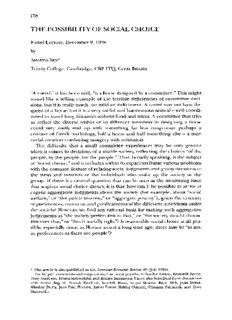
by - Core
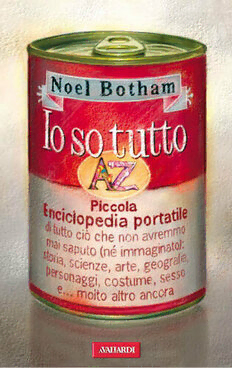
Io so tutto: Piccola enciclopedia portatile di tutto ciò che non avremmo mai saputo

Econometría Aplicada II

Meet the Masters

Greek Government Gazette: Part 4, 2006 no. 465

Project 1 - Workbook (3rd Edition)

Tic Disorders, Trichotillomania, Other Repet. Behav. Disorders
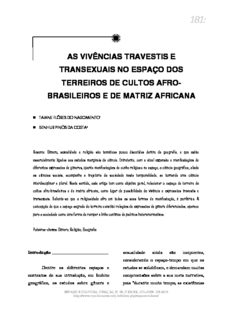
as vivências travestis e transexuais no espaço dos terreiros de cultos afro

NOTAS SOBRE A TEORIA DOS PRINCÍPIOS DE ROBERT ALEXY Natália Braga Ferreira NOTES ...
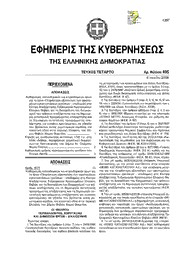
Greek Government Gazette: Part 4, 2006 no. 495

Tomato container gardening: 7 easy steps to healthy harvests from small spaces
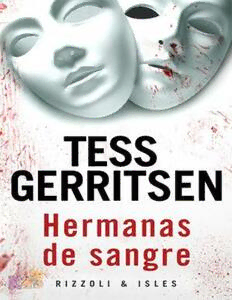
Hermanas de sangre
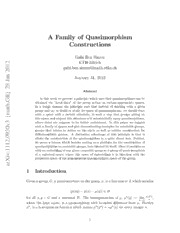
A Family of Quasimorphism Constructions
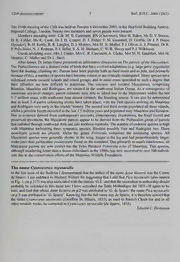
The name Cyanocorax mystacalis

Development of prey-specific predatory behavior in a jumping spider (Araneae: Salticidae)

The Guardian - Oct 9 2020
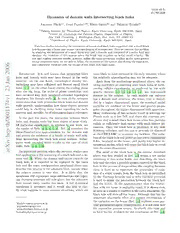
Dynamics of domain walls intersecting black holes
